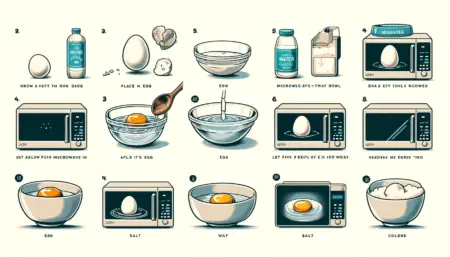Can you cook an egg in the microwave? The answer is yes. Have you ever thought you could prepare a boiled egg in the microwave ? If you want a quick dinner, without turning on the stove or oven, it’s the perfect solution. Making a hard-boiled egg in the microwave doesn’t have too many complications, but it does have some considerations that you should take into account to avoid any surprises in the kitchen.
Can You Boil an Egg in the Microwave; Preparing a boiled egg in the microwave.

1) To prepare the boiled egg in the microwave you will need, in addition to 1 or 2 eggs , some boiling water , which you can bring to temperature in the microwave (remember not to fill it to the edge of the container in which you heat it or egg will make it come out!).
2) Gently insert the egg or eggs into the cold water and then cover the bowl with a saucer. Be careful: the egg may even explode if the heat is excessive!
3) Cook for 7 minutes at medium power, then let it rest for about ten minutes before peeling your hard-boiled egg in the microwave under a jet of cold running water.
How to Boil an Egg in the Microwave: A Step-by-Step Guide.

oiling an egg in the microwave is a quick and easy method when you’re short on time or don’t have access to a stove. However, it’s important to follow specific steps to avoid any mishaps. Here’s how you can safely and efficiently boil an egg using your microwave.
What You’ll Need:
- Eggs
- Microwave-safe bowl
- Water
- Salt
- Fork or pin
- Microwave-safe plate
- Oven mitts or a kitchen towel
Step-by-Step Instructions:
Step 1: Prepare Your Ingredients
Before you begin, gather all the necessary items. Choose fresh eggs, as they tend to cook better and are less likely to explode in the microwave.
Step 2: Pierce the Egg
Using a fork or a pin, carefully pierce a small hole in the bottom (wider end) of the egg. This step is crucial because it allows steam to escape during cooking, preventing the egg from bursting.
Step 3: Add Water and Salt to the Bowl
Fill a microwave-safe bowl with enough water to completely submerge the egg. Add about half a teaspoon of salt to the water. The salt helps prevent the egg from exploding and makes peeling easier after cooking.
Step 4: Submerge the Egg
Gently place the egg into the bowl of water, ensuring it is fully submerged. If necessary, place a microwave-safe plate on top of the bowl to keep the egg underwater.
Step 5: Microwave the Egg
Place the bowl in the microwave. The cooking time will vary depending on your microwave’s power and how you like your eggs. Here’s a general guideline for a medium-sized egg:
- Soft-Boiled: Microwave on high for 3-4 minutes.
- Medium-Boiled: Microwave on high for 5-6 minutes.
- Hard-Boiled: Microwave on high for 7-8 minutes.
Keep an eye on the egg while it cooks, especially the first time you try this method, to avoid overcooking or undercooking.
Step 6: Let the Egg Sit
After the microwave stops, leave the egg in the hot water for an additional minute or two. This helps complete the cooking process.
Step 7: Remove the Egg
Using oven mitts or a kitchen towel, carefully remove the bowl from the microwave. The water and bowl will be very hot, so handle with caution.
Step 8: Cool the Egg
Transfer the egg to a bowl of cold water or run it under cold tap water for a few minutes. This stops the cooking process and makes the egg easier to handle and peel.
Step 9: Peel and Enjoy
Once the egg is cool enough to handle, gently tap it on a hard surface to crack the shell and peel it off. Rinse the egg to remove any remaining shell fragments.
Tips and Tricks:
- Use fresh eggs: Fresh eggs cook better and peel more easily.
- Monitor closely: Microwaves vary, so keep an eye on the cooking process, especially the first time you try this.
- Experiment with timing: If the egg isn’t cooked to your liking, adjust the cooking time in 30-second increments.
Safety Precautions:
- Pierce the egg: Always pierce the egg before microwaving to prevent it from exploding.
- Use a microwave-safe bowl: Ensure the bowl and plate are microwave-safe to avoid accidents.
- Handle with care: The bowl and water will be extremely hot, so use oven mitts or a kitchen towel when removing from the microwave.
Boiling an egg in the microwave is a convenient alternative to traditional stovetop methods. By following these steps and safety tips, you can enjoy perfectly boiled eggs in just a few minutes.
Conclusion
In conclusion, yes, you can boil an egg in the microwave if you follow the proper steps to ensure a safe and successful result. By pricking a small hole in the eggshell and microwaving it in water, you can enjoy a perfectly boiled egg in just a matter of minutes. So, next time you’re in a rush and craving a boiled egg, give the microwave method a try and see how easy it can be!
